A few weeks ago, I returned home from Athens. It has been an incredible journey filled with amazing people whom I am so happy to have met here, the places and roots of my studies and the best adventures. I love the culture and people here and feel at home in Greece. Greece kept me interested and happy for my whole four months, and there’s nothing more I could want in a city. There are immediately a handful of things I can think of that I didn’t get to do this time around, so I know I’ll be back. Σας αγαπαω! Until next time!
Friday, May 30, 2014
Friday, April 18, 2014
Sophie, Lucy and I stayed at Perissa beach, where the sand was black and there was a nice strip of restaurants. It wasn’t crowded, but we had been told that Greeks who went to the beach on Santorini went there. The weather allowed us one nice afternoon on the black sand, which was perfect because although the wind was a bit chilly, the sand itself warmed us up.
Otherwise, we visited Fira where we rode the donkeys and Oia the next day. Supposedly, the distance from Fira to Oia is hike-able, but we chose to hike only a part of it to explore a cool looking area of the coast.
Most of these pictures are from that hike, and the next round should have some as well!
SANTORINI
From Monday to Thursday of this week, I was on Santorini with my friend Lucy from CYA and her friend from home, Sophie, who is currently studying abroad in England. It was as beautiful as everyone said it would be even though it wasn’t the season for visitors! The classic white-washed walls and blue domes and doors is exactly what we saw in the cities here.
On our first day we explored the town of Fira, rode donkeys up and down the mountainside for about a 30 minute ride and went on a nice hike. Fira was beautiful with winding streets, beautiful boutiques and nice cafes with views of the caldera. The donkeys were definitely fun, but much more unstable than we expected and the poor things were sweating bullets and it was only April! I can’t imagine how hard they are worked in the summer and I almost wish we hadn’t done it. But they looked like they were treated well enough! More pictures to come…the order is a bit scrambled.
AEGINA
On Sunday, I went on a day trip with Fiona to one of the nearby islands for my free day before going to Santorini. We had decided to go to the port, Piraeus, together, see the ferry schedules, pick an island and go. We had hoped to visit Hydra, but since the ferries were full, we ended up en route to Aegina, a major island only an hour ride from Athens. For some reason I had had some prejudice against going to Aegina for a day, but I was so pleasantly surprised and charmed!
We arrived and promptly found a café for lunch (since I had been up at 5 that morning and was starving) and wandered around the town for a half hour or so. The boutiques all had a style that somehow Athens lacks and really ought to have! Many of them had the decorated candles that Greeks use the night before Easter for the tradition of spreading the light that they fly over from Jerusalem. They fly the light over, then spread it through all the churches and from candle to candle so that everyone holds the same light originating from Jerusalem. The candles I saw were ornamented with symbols of different hobbies. When you give someone a candle as a gift, you give one that represents that person’s interests.
We found our way to the bus stop, but found out that we had missed the last bus to the other side of the island! Fiona and I had really wanted to see the temple to Aphaea (a local goddess who does not have any other temple aside from this one on Aegina) as well as a particular monastery. Luckily, we rented an ATV to share! It sprinkled a bit that day and wasn’t too sunny, so we froze a bit, but, again, driving around was a great way to see the island. We made it to the temple, another of the towns that was recommended (but it was basically a ghost town), and the monastery. I think both Fiona and I were surprised at how much we enjoyed this monastery. We have visited a few this semester with CYA, but something about this one or being there on our own was very special. Back in the port town, we had to buy some pistachios because Aegina harvests them there. All in all a great adventure day!
Saturday, April 12, 2014
Marinetta
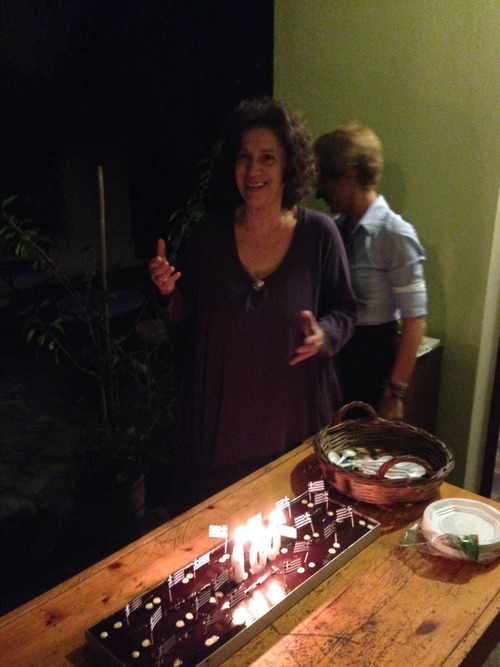
Marinetta is my wonderful Greek teacher, and this past week our class went to her house for dinner. It makes me so happy to see her happy. She had her daughter and her two grandsons help out with serving us and playing the music that she wanted to teach us. She must have cooked for hours to prepare!
She always takes time to explain the Greek way of life and is so clearly proud of everything Greek. I love this window into Greek culture compared to what young people from cafes tell us. Obviously her perspective is a bit different, but I appreciate hearing her view of everything. She is definitely my favorite Greek.
More from Crete
My favorite part of the weekend in Crete was a stop in Margerites, a small village that specializes in ceramics. We stopped for coffee in the morning and for a demonstration at one of the workshops. The artist was energetic, clear (spoke English very well), passionate and talented. He showed us how their designs depend on engineering and demonstrated how to make these very clever salt and pepper shakers on the wheel. He explained this certain symbol on all of the pots that marks any piece of ceramics as a product of Margerites. We all went crazy buying things because it was so fun to see - I hope nothing breaks!
We visited a semi-active monastery, a sleepy beach town that was a favorite of hippies back in the day (Today is life; tomorrow never comes), and basically saw the beautiful scenery and ate delicious food! I had a whole plateful of snails because they are supposed to be great on Crete.
My last picture is with Vasso, the CYA coordinator for the trip. I adore her, along with everyone else on the program, and taking a picture with her has been on my bucket list. Check.
WEEKEND ON CRETE
The CYA trip to Crete was an amazing time! We saw the most important archaeological sites, like Knossos and Mallia, but we had plenty of free time in various small towns to stop for coffee or lunch and in Heraklion where our hotel was.
Some of these photos are from Knossos, which was mostly interesting to see because it was reconstructed (and not many sites are reconstructed). The pictures I have of wall paintings are the originals, which we saw in the museum at Heraklion, but they were copied and placed on the site as well. Mallia wasn’t reconstructed, so I got to see both approaches to a site in a single morning. I still can’t decide how I feel about it. I wish they could leave the site as it is, but build a reconstruction somewhere else as a museum where they could offer the experience of being in the fully built (or as much as is possible to reconstruct) palace. Knossos was also really cool because there were so many peacocks!! I’ve decided they are real life mythical creatures.
These pictures aren’t very organized - they’re from Mallia, Knossos, the museum, a beachside town where we stopped for lunch and Heraklion. The last is from Heraklion, but it deserves some explanation. My friend Lily has a disposable camera that she saves for only select pictures. We were at this bench and looking to use it for a picture so she suggested we lie upside down on the bench. These tourists in the picture were at the same spot taking pictures, LOVED the idea, took our picture doing it, came over and forced me to sit up to see how great of a picture it was on their camera, then insisted on taking the same photo themselves. So that’s how I have this picture!
Thursday, April 3, 2014
Mount Lykavettos
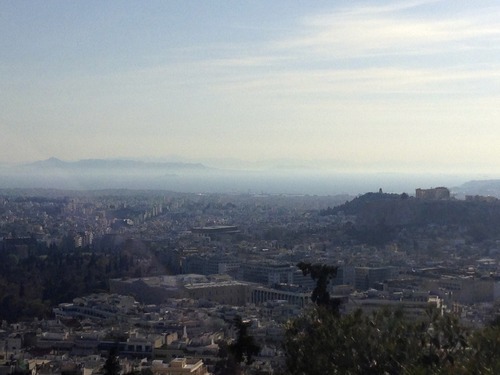
On the Sunday after returning from Thessaloniki, a few friends and I hiked Mount Lykavettos for the view, the cafe, and so that we could cross it off our bucket lists. This is one of only a few mountains that interrupt the relatively flat city of Athens, and you can see it from almost anywhere. The hike was short but steep and offered an amazing view. My picture shows the Acropolis and the sea behind it. We didn’t plan on staying for long, but at the top it was too beautiful to leave, so we ended up staying until well past sunset. One of my favorite afternoons!
More from the field trip to Thessaloniki and northern Greece
A walk through a fish market, one of the many beautiful churches we toured, Fiona on top of the world, and three pictures from the site that claims to be the school of Aristotle where he taught Alexander the Great.
Northern Greece
Pictures from our second field trip - this time we went to northern Greece, mainly to see Thessaloniki and Pella. The first picture is Mount Olympus, which we passed from the bus. It’s huge! At the port in Thessaloniki, the sky was perfectly clear, and the only thing in the sky that looked like clouds was actually the snow-capped top of Mount Olympus in the distance. The second picture is from a small tour we took at Ambelica on the drive up to Thessaloniki - this town is very small, but it was worth the stop because it had its own kind of Rennaisance in the 18th century when they discovered that they had the resources to manufacture and trade a special color of dyed cotton. The town educated their people in business and languages so they could trade successfully. This painting is from the house of one of the very influential families, and it shows the port of Istanbul. That was cool to see after revisiting Istanbul the previous weekend with my family!
Then I have a couple of pictures of the water at Thessaloniki, which is right next to a strip of nice bars and restaurants. We had much more free time on this trip than we had in the Peloponnese, so we were able to explore this area a lot!
While we were there, Thessaloniki was hosting its annual documentary film festival, with international documentaries playing all day. I got to see two documentaries, one on the hostage crisis in Tehran, and another on an American man who went to live with Pigmies in Africa. I also got to go on a walk through a certain neighborhood of Thessaloniki with a CYA professor who specializes in ethnography, so I learned a bit about the population exchange between Turkey and Greece a couple of generations ago. We also visited an art exhibit (I have a picture of it) featuring a photographer’s work on the crisis in Greece.
We spent about three days in Thessaloniki and one visiting Pella, the city where Alexander the Great and Phillip came from. The site itself was not particularly impressive, but it’s always cool to see where these people lived!
Tuesday, March 11, 2014
Carnavali Patrino, Carnaval in Patra
My friends and I had heard about Carnaval in Patras from our first few weeks in Greece, so we planned to go for the weekend of Clean Monday (March 3rd)! We knew very little about the weekend: we could compare it to Mardi Gras (which Hannah loves since she goes to Tulane), we had been told by many Greeks that this would be the craziest weekend of our lives, and we had been advised to get costumes. My friend Julia from Germany whom I met at Taft four years ago was coming to Greece to visit, so I told her to bring a costume. Luckily, she just HAPPENED to have a wig. Perfect. We all bought wigs at a party store in Pangrati to be properly prepared.
At the bus station on Friday, it seemed like the whole world was going to Patras! Patras is relatively big for the Peloponnese but small compared to Athens, so it was overloaded with people. Hannah, Catherine, Julia and I stayed in a hotel about 14 km outside of Patras so we had to prepare for the whole day and night when we left in the morning. On Saturday, we prepared for all the hype we’d heard about, putting on our wigs, masks and sparkles. The picture is the four of us at 11 in the morning. The bus and coffee that day were both a bit painful since we were the ONLY people dressed up! Soon enough we ditched the wigs and put them on later when other people were wearing costumes!

Over the weekend we went on a few of the carnival rides, hopped from street meat stands to street meat stands and various cafes to avoid the rain, watched the two 3 hour long parades and danced in the streets. We had the special black wine made and sold in Patras for the occasion, traded costume pieces with people and met a ton of Greek students - all in all a great first Carnaval!
Wednesday, February 26, 2014
KATHIMERINI
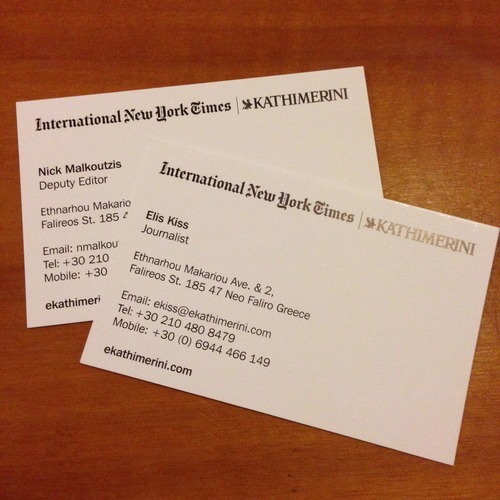
Last night I began my internship with the English edition of the Greek newspaper, Kathimerini! I wasn’t expecting to pick up something like this while abroad, but I found that I have a lot of free time so I thought it would be worthwhile to research extracurricular options. Nadia, the student affairs director, took my request to find some sort of economic volunteer job very seriously, pulling strings like one would for a child. After sending her my resume she set me up with Kathimerini because her friend is the editor! Basically, Kathimerini is one of the leading if not THE leading Greek newspaper, and there is an English edition that is published online as well as in the form of a paper insert that accompanies the International New York Times.
Last week I went in to meet them (at 8:00 because papers work late and I have class before then) to see how I could help. I’ll be going in on a handful of Tuesdays at 7:45 when I am done with class. Last night Nick, the deputy editor, gave me an “exercise” to start with. I read the European Commission’s winter forecast for 2013, 2014 and 2015 as well as a report specific to Greece, then synthesized the forecast for Greece in the context of the eurozone. I haven’t done much macroeconomic analysis, but I thought it was a manageable task! At the end of the night as I was walking with the others who were at the office until 11:15 to carpool back to Pangrati, one of the women told me to think about one or two stories I might like to write for them while I’m here! It seems like I may be published before I leave Greece!
Greek cooking class
On Monday after getting back from Istanbul I took the Greek cooking class offered in the program’s lunchroom with Meni, my new friend to say hi to! So far I’ve only known Despina in the lunchroom, but now I’ve spent some time with Meni too! The 7 students who signed up all went into the kitchen to make spanakopita, tzatziki, bifteki and french fries. We’re getting the recipes later this week!

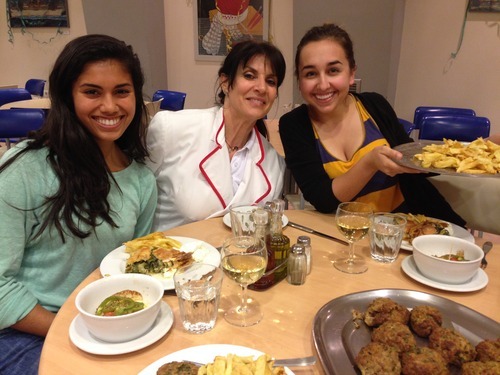

After cooking we all sat down to our home cooked feast!

ISTANBUL
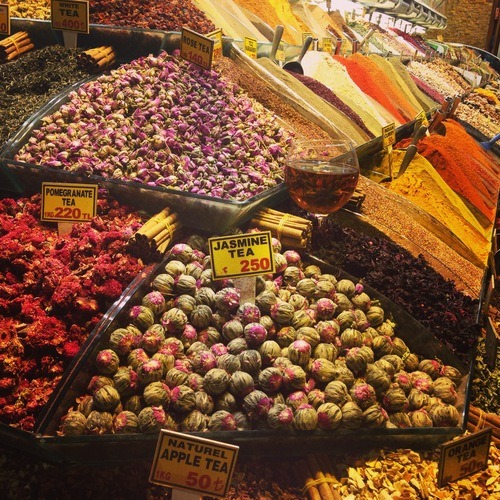
I spent the past weekend in Instanbul with a few friends from my program, so here’s a brief account of everything!
We had all of Friday, Saturday and Sunday, so it was ample time to explore, see the tourist hot spots and some other things we hadn’t heard about before.
On Friday, we walked from our hotel down the main shopping/walking street called Istaklal Street to get to the other side of the bridge where the Hagia Sophia and Blue Mosque are. From the bridge we could see about 5 mosques, and guessed that one was the Blue Mosque. It wasn’t the Blue Mosque (should have guessed by the lack of tourists), but we got to explore the Suleymaniye Mosque instead! We passed through the Egyptian spice market on our way to the actual Blue Mosque after, and saw the Blue Mosque as well as the Topkapi Palace. We went out to a Turkish dinner, then went to bed early since we were exhausted from a 7 am flight and walking all day!
On Saturday, we spent hours in the Grand Bazaar, being shouted out by the merchants to buy things, pick up the things we had supposedly dropped, and being called, “Spice girls!” I thought some shopkeepers in Athens were pushy… The six of us went to another Turkish restaurant for lunch, then I went off with my fiends Catherine and Lucy to go to a Turkish bathhouse. That was QUITE an experience! The hamam was built in 1481, and we could tell that this spa-like experience was much more deeply rooted in the Turkish culture than any spa is in the US. On our walk back from the hamam we ran into a riot on Istaklal street, which simultaneously intrigued and overwhelmed us. We watched from the entrance to a mall, tried to pass by it on the edge of the street, ran back to the mall when everyone else started running, tried again to leave the opposite direction, jumped when something exploded in the streets, were allowed to pass by a line of police who were blocking off a side street, and booked it back to the hotel! At the restaurant later that night, the waiter apologized for sniffling - he said he was reacting to the tear gas from the riot we saw! After dinner a few of us tried out a hookah bar to unwind and stay up a bit later.
Sunday was relaxing and a great end to the weekend. Catherine, Fiona and I were on a flight back to Athens in the evening, so we leisurely returned to the Hagia Sophia (directly between the Blue Mosque and Topkapi Palace) and spent a good hour inside. It was amazing, but I definitely wished I had some sort of tour guide! Otherwise we wandered, shopped, and had a relaxing day in the city before flying back to Athens. Such a great trip!
DELPHI
Delphi was my second favorite place to stay after Nauplion - it was very charming, also hospitable, and had amazing views of the mountains!
We got to tour the museum here with Anne Stewart again, and I have a picture of her in action above.
In all honesty, the site plan was too complicated for me to remember exactly what I saw, but I think the view gave the entire sanctuary part of its power. Being up above these ruins for an hour definitely required me to stop and take it all in. I saw the statues, friezes and sculptures in the museum that were on buildings and on the top of pillars, so I can only imagine what it would be like to walk through this site thousands of years ago!
The Sites at OLYMPIA
The modern village of Olympia is nothing extraordinary, but the people were very hospitable and kind! The museum at Olympia was my favorite of the whole week mostly because we were guided by the sculpture professor, Anne Stewart, who has a wonderful, engaging teaching style for on-site lectures. She told a story that really attested to the connection between modern Greeks and the ancient Greeks that I don’t want to forget:
Some years ago (I forget how many) she was watching the Greek news and saw the headline, “Ancient Olympia Museum in Flames.” As a specialist, she was very upset by this, but luckily the townspeople came to the rescue. Apparently, as the fire spread through the town and had reached most of the residents’ homes, it approached the museum. When the townspeople saw that the fire was almost at the museum, they abandoned their homes to go save the museum! The government gave the town a hefty amount of money for rebuilding their homes as repayment for their public service!
The first tableau I have above only includes the central figures of the frieze from the Temple of Zeus. It shows the scene of the chariot race between Pelops and Oinomaos. They stand on either side of Zeus to swear their honor and that they will not cheat (Pelops does not keep this promise). Pelops’ wife and daughter stand close by worrying about the coming race. It’s fitting that Pelops and Oinomaos were promising not to cheat in Olympia where the Olympic games began and drew many athletes who all took the same pledge! I saw the row of statues necessarily dedicated by the cheaters line the entrance to the ancient stadium!
Next are the statues of Hermes with Dionysos on his arm and the Nike of Paeonios. Notice the turtle under Nike’s foot!
Next is an illustration of Herakles’ labor to get the golden apples of the Hesperides by holding up the sky for Atlas while Atlas does the task for him. At the moment of the frieze, Herakles is holding up the sky and Atlas is holding the apples. Herakles looks at the apples as Atlas looks at Herakles, both acknowledging that Atlas could take the apples and be free of his horrible task!
Next is the workshop of Pheidius, the renowned Athenian sculptor who is supposedly the sculptor of the colossal gold and ivory statue of Zeus. Then is a toppled column from the Temple of Zeus, which housed this legendary statue of Zeus. Its drums fell just like dominoes and remained there ever since!
My friend Kristin is next to a fallen capital of one of the columns of the Temple of Zeus behind her. The capital matches exactly (in size and design) the capital at the top of the standing column in the background of the picture!
Next is the Temple of Hera, and then Kristina and Fiona in the workshop of Pheidius.
More from MYSTRAS
This Byzantine fortification and monastery is only a 10 minute drive from Sparta, so as we climbed (and climbed and climbed) to the top we could see Sparta beneath us. I’m not so sharp on my history, so I won’t go into it and risk getting it wrong. To say the least, this was one of my favorite sites of the week! We stepped inside two Byzantine churches to see it from an art history perspective. The faces and eyes of the figures on the walls and ceilings were mostly destroyed. I have a picture above of small plaques left in the churches that represent the ailments that worshippers prayed to the gods about. I thought those were very cool to see, since in the museum at Edipdaurus we saw stone carvings that served the exact same function at the Temple of Asclepius!
SPARTA
After spending two nights in Nauplion my bus (there were two buses) spent Wednesday night in Sparta! Amazingly, the movie 300 was on TV that exact night, so I have now watched 300 while I was in Sparta.
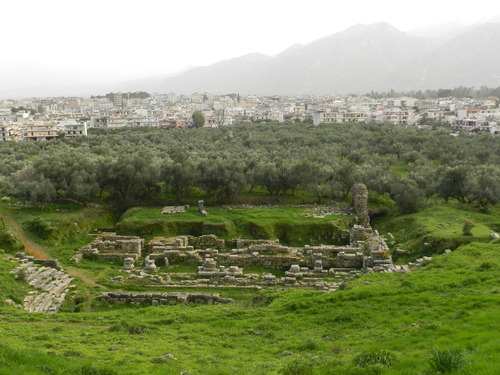
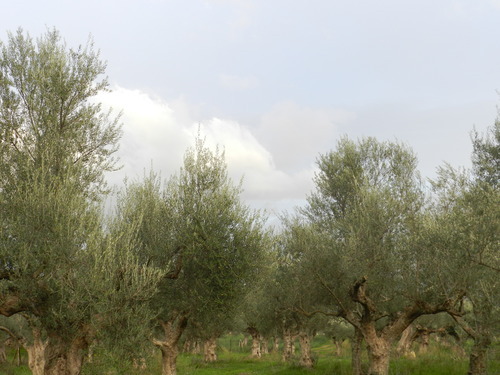
When we arrived, we hiked up to the acropolis of ancient Sparta, which really wasn’t so much to see. However, from the acropolis we could see a beautiful olive grove at the base of the hill.

After seeing this there wasn’t much to do, so I went down to the track at the end of our hotel’s street (past the massive statue of King Leonidas) to run. Within my first few laps I fell into step with an older man who spoke no English whatsoever, but as we weren’t running at different paces, I tried to give my Greek a go. It was especially funny to find a comfortable pace for both of us using the words for “slowly, slowly,” “come on,” “I’m ok,” and some sign language. Here is what I *thought* I understood after our 30 minute jogging conversation:
His name is Niko. He works as a chef in a taverna named Varlas in Sparta, but there is also a second location of Varlas in Athens. He has been to Canada. He runs marathons, ran THE marathon possibly last fall, and is preparing to run a marathon to Tripoli from Sparta. The reason he can run so fast is because he drinks red wine. He is 50 something years old. He does not speak any English.
With my baby Greek, I think that we talked about my program, the itinerary for my weeklong trip, where I was from, Greek food, marathons, track and field events (apparently they don’t have pole vaulting in Sparta…).
After rallying a group of friends to find Varlas, I learned that I should not be so confident in my Greek. I asked the servers at the taverna if they knew Niko, and, first of all, they barely understood my question. By the end of the meal we had found someone in the restaurant who spoke both English and Greek, and through a few conversations it turns out that Niko had merely RECOMMENDED this taverna, and that he did not work as the chef. Silly me. Either way, I made it through a 30 minute conversation in which I didn’t speak any English!

LERNA and TIRYNS
On Wednesday we visited Lerna, home of the Lernaean Hydra, another of Herakles’ labors, and Tiryns, both in the Argolid. We saw the House of the Tiles, named so because there were tiles on the roof. That’s the first picture. The site was relatively small and not as impressive as Mycenae or Tiryns, but I still enjoyed it, especially when our professor pointed out the herringbone masonry! Shout out to good old Herringbone and her happy sailors!
At Tiryns we saw more cyclopean structures (walls built with impressively large stones), shaft graves and access to water within city walls. It is similar to Mycenae, perhaps made with even bigger stone blocks. My group discussed it in relation to Mycenae for the paper we have coming up, so we hypothesized about the kind of relationship these two citadels had.
My second to last picture is a tunnel within the wall at Tiryns, which my dad will enjoy: It was roped off so I couldn’t go down the passage, but at the end on the left of the picture there should be a slight shine on the stone. When shepherds would lead their sheep through this tunnel, the sheep’s wool buffed and polished these stones so that now they shine! Just a fun fact!
EPIDAUROS
The theater at Epidauros is one of the most impressive structures we saw, because its acoustics completely carry sound from the orchestra to even the highest seats. It was amazing to sit on the stone seats (so comfortable!) while different groups of students climbed up and down, yelled to each other, and the whole time sitting in the audience I had a beautiful view of the mountains in the background. Not too shabby!
We then toured the site of Epidauros that includes a Temple of Asclepius, the Asklepieion of Epidauros (where the ill could come sleep, connect with the gods and be healed), a Temple of Artemis, the Abaton Dormitory, a hestiatorion (place for ritual dining large enough to fit masses of people), and a Roman Odeion (enclosed performance hall with a rounded audience). The site was a large field of ruins, large blocks and a few surviving columns here and there. One of my pictures shows a rounded structure, which was a sort of tholos (meaning round…like the tholos tombs at Mycenae) temple with Corinthian column capitals and an intricate foundation that suggests the possibility that there once was a labyrinth of snakes below the temple. The professors who accompanied us and guided us around the site assured us there was no evidence to support this myth, but it would have been cool!
The last picture is a Mycenaean bridge that we saw just as a quick pitstop along the present-day highway. Those stone blocks are not small!
NAUPLION
People had told me about Nafplio/Nauplion/Ναυπλιον as one of their favorite places in Greece, and now after spending two nights with free evenings there I love it too! Our program for the field trip was great, because even though we got up early to begin our days (partly because the museums we visited had shortened winter hours and we had to make it early enough…) we were free around 5 or 6 to explore, find gyros, gelato, watch the Olympics…you know, as one must do. We visited the museum at Nauplion on Wednesday to see the artifacts from Franchthi Cave, which was inhabited from 40,000 to about 3,000 BC. Otherwise, we were free to explore!
Upon arriving early in the afternoon on Monday after seeing Mycenae, Vasso made a quick edit to our itinerary so that we could see the Palamidi castle. It is a huge fortress with 999 steps leading down the cliffside. The restaurants had dishes named for these 999 steps as their object of local pride. I caught a picture (above) of these steps just as the sun hit them right before it set!
These pictures are either from our hour of exploring the Palamidi Castle, from the walk along the water that is lined with cafes, or it’s the picture of these butt-chairs that I wasn’t lucky enough to sit in. At my roommate Eleni’s recommendation (she is a full-year student so she came on this trip last semester), we went to a certain gyro place twice. The best tzatziki! Also, they happily changed the channel so we could avidly watch the Olympics! We only saw some curling, but at least it was something!
MYCENAE
First stop was just after crossing the Isthmus Canal (I have one picture from this stop and the rest are from Mycenae) to see how deep and narrow the canal is. We could see one boat passing through with little room on either side…definitely amazing compared to the Cape Cod Canal! Our professors also pointed out that people throughout the past few thousand years had tried to create this channel, and showed us the signs of previous attempts. Very cool!
On the bus to Mycenae we passed by Mount Parnassus and through the region of Nemea, home to the Nemean Lion (one of Herakles’s famous labors) and the Nemea wine that Hannah and I got from wine George!
Next we toured the ancient site of Mycenae. We saw Grave Circles A and B, although my class had visited the goods from these burials in Athens at the National Archaeological Museum before the trip, the shaft graves and tholos tombs typical of Mycenaen civilization. One tholos tomb is named the Tomb of Clytemnestra, but it has nothing to do with her, just as the Treasury of Atreus does not necessarily have anything to do with him.
#1: View of the site of the Mycenaean city center.
#2: Vasso, the trip coordinator for CYA, standing just up one level from the site of the palace. She is one of my favorite Greeks ever!
#3: The Treasury of Atreus.
#4: Tim, Kristin, Fiona and Lani at Mycenae.
#5: The Isthmus Canal at about 8:30am (we left Athens very early).
#6: With Fiona and Kristin at the Lion Gate!
#7: Some friends standing on the mound of earth above the Treasury of Atreus.
#8: More friends in the entrance hallway to the Treasury of Atreus.
#9: The supposed “tomb of Clytemnestra.”
#10: Grave Circle A.
Sunday, February 16, 2014
Peloponnese Trip!
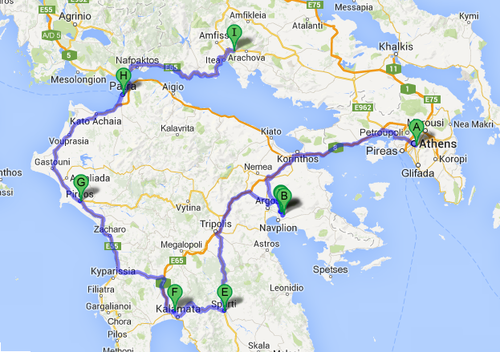
This week, Monday through Saturday, the program is taking everyone on a big tour of the Peloponnese! We’ll drive on buses, spend the nights in three different cities and tour Nafplio, Mycenae, Tiryns, Sparta, Kalamata, Pirgos, Patra and Delphi. On this past Tuesday an acclaimed historian gave a presentation at CYA on the more recent history of the Peloponnese to prepare us for the trip. He was a very entertaining storyteller and told us stories and fun facts from the Crusades to present day. I can’t wait!
From Γεια σας to Γεια σου
It’s amazing to think that I’ve been in Athens now for three weeks as of tomorrow! I’ve gotten used to jaywalking on every street, eating dinner at 9:00 at night, and resenting the ATMs for giving me 50s, which small coffee shops will frequently refuse. Greek has formal and informal conjugations of verbs and pronouns, so that you first say Γεια σας as “hello,” but once you know someone after as little as one meeting, you can address them with Γεια σου! This literally means “health to you,” but just hello in everyday conversations. Instead of “cheers,” the Greeks say Γεια μας, “health to us.” I’ve made it to Γεια σου (the informal one) with a handful of locals here, so I think that means that Athens feels like home!
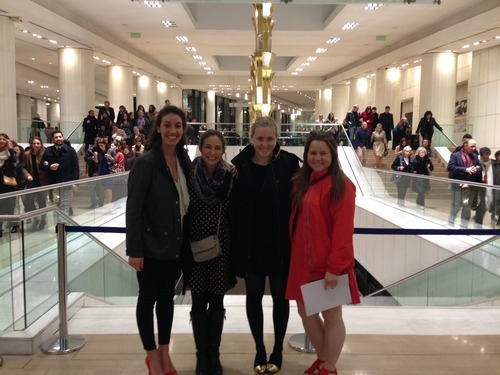
Just tonight I went to the Megaron with Catherine, Francesca and Rachel to see the Russian Ballet’s Swan Lake! The theater was filled with the CLASSIEST Greeks I’ve seen yet…but there were very few Americans, so that was cool! Despite the crisis, there are about 16 functioning theaters in Athens, all mostly full. The Megaron hosts concerts, lectures and performances with special offers for students, so I am sure I’ll be back sometime in my next three months!
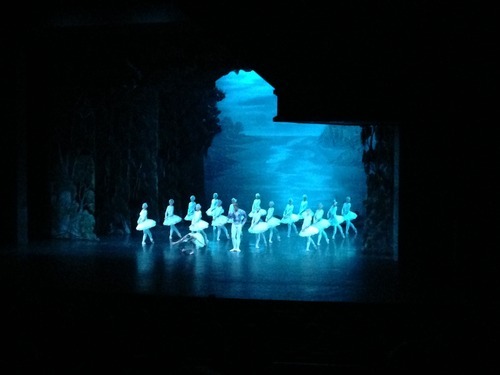
First two pictures are from the weekly farmers market that comes go Παγκρατι, our neighborhood, on Fridays called the Lycee (couldn’t figure out how that one was spelled in Greek). The honey stand lady gave us taste tests before we ended up buying honey from a fir tree!
The next three pictures are from a night a few weekends ago when a handful of people from my program went out together to a karaoke bar. It was pretty ideal that we dominated this one place and that there were very few Greeks. That way we didn’t have any opportunities to be embarrassed of being too American since we were all American! I have a picture with the other Lucy on the program - we both can’t believe there are two of us on this program since we rarely meet other Lucy’s our age!
Hannah, Catherine, Rachel, Fiona, Francesca and I found a 24 hour crepe place that delivers in Κολωνακι, one of my favorite areas of Athens! I’ve gone back to explore on my own a few times already since going the first time. Κολωνακιis a high end area with lots of fashion stores and patisseries (and therefore lots of French on the signs!).
The next three pictures are from Πλακα, one of my other favorite areas that I’ve seen so far! It is slightly touristy, but less so than the main walk up to the Acropolis, and it has more art galleries than generic tourist shops. We found a really cool store with exotic dried fruits where I got a mix of hibiscus, aloe vera, goji berries, and the best dates I’ve had in my life! While walking around Πλακα we came across at least four different ruins and monuments, including the Choragic Monument of Lysicrates (in the picture with Hannah and Francesca).
The last picture was the poster on the back of the door in a restroom at a restaurant. Just read it until you hit the phrase, “You ugly diamond…”
I visited “the big rock” next to the Acropolis to see the sun set after class one day, but it was a bit too overcast to see the sun. There probably is a better name for “the big rock,” but I don’t know it yet. The first two pictures are from that perspective.
Next are three pictures of graffiti, which covers many buildings in Athens! As my modern Greek teacher told me, the young people don’t care to see beautiful things, so they draw graffiti everywhere. Granted, she is a bit older and knew Athens without all of the graffiti it has today. The exception, she showed me, is the white house with blue shutters: this is the home of a Nobel Prize winning poet, and they respect him, so there is no graffiti on his home.
Next is a church from the time of the Turkish - Ottoman occupation of Greece. Churches of this style are sprinkled throughout the city, all with domes at the top, made of the same roof materials and in prime intersections in the city.
Last is the Greek flag made of feta and olives :)
A Cafe Lifestyle
I’ve come to realize while I’ve been here that I’m not a big coffee drinker. I love my espresso, or maybe a cappuccino, but I think it’s best in small quantities. However, during orientation, the program introduced us to frappes, which have the caffeine of four cups of coffee, warned us of past students who have ended up in a doctor’s office from too much in a day… and taught us how to make them at home with instant coffee, an ice cube and a cheap go cup that looks like a sippy cup. I tried my first frappe over the weekend. It was my last!

There are a number of cafes close to the apartments and the center, and I’m trying to test out as many as I can. The one closest to school, named Stadium cafe after the Panathenaic stadium just around the corner, has these cups to amuse the many CYA students who visit from semester to semester. We’ve realized that they give the pink cups to the women and the grey cups to the men. I’m challenging myself to be on a first name basis with the shop owners I visit often. So far, Gregory at Stadium is one of my first local friends!
Some cafes close around 3:00 in the afternoon because Greece has quiet hours, and many businesses close during that time only to (maybe) reopen (some days…I’m not sure which yet) around 5 or 6. I had to hunt for a while the other day to find one that would not close for the siesta, but landed at one with a handful of old men reading the paper. I felt slightly out of place as I opened my workbook to begin copying the alphabet…
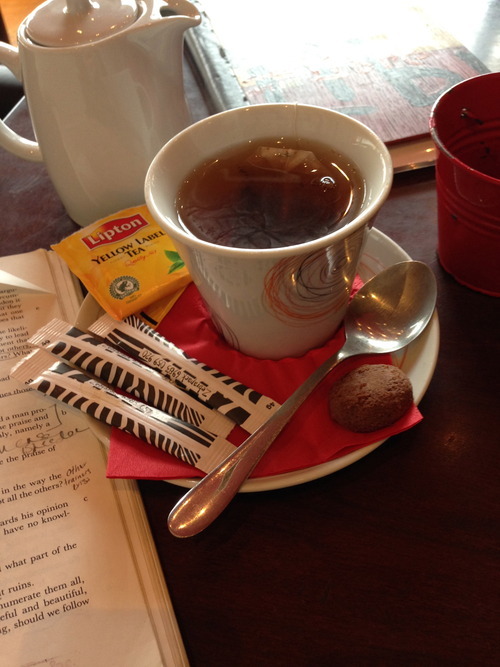
Everyone spends lots of time in cafes, because by buying even a simple tea or coffee, you effectively have rented the table and are free to stay. In the US, you can be pressured out of a restaurant or cafe for sitting for hours and buying only one thing, but this is normal here!
Wednesday, January 29, 2014
First Impressions
I’ve made it to Athens! I’ll be living in this beautiful city for the next four months of my life, doing my best to learn the city, become a local, and make the most of each day.
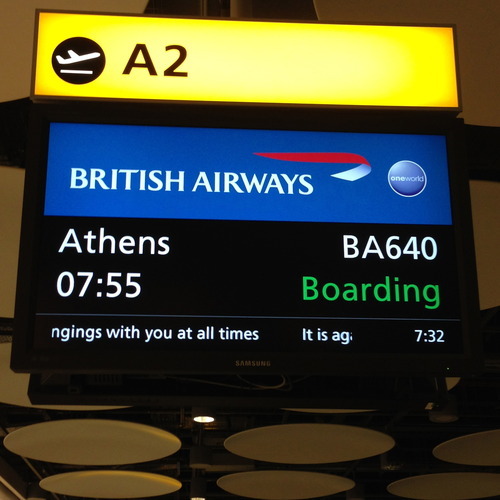
I live in a simple but beautiful apartment in the neighborhood of Pagrati that is close to the center of the city with four other amazing roommates from my program, College Year in Athens. I’ve already seen that CYA is clearly a well-established program over 50 years old that seems to offer many opportunities to see the city from an academic perspective and to dive into Athenian culture. About 80 students are here with me at CYA, all from various schools around the US. I’ve already met some really great people!
Most of my days have been structured with orientation activities, but a group of us ventured to the Acropolis during a long lunch break on my third day here! I rallied a few of us to go, including one full-year student who was more than willing to tour us around and tell us fun facts he had learned from his ten visits to the site last semester. It seems pretty standard to visit the archaeological sites in Athens multiple times during a semester! It was amazing to climb the Acropolis and finally see its context. In classes at home, it is difficult to imagine how it is in person, but it’s right in the center of the city. One of my favorite things from that trip was THE olive tree of all olive trees (the picture at the top of my blog, and perhaps the inspiration for my title…). When Athena competed against Poseidon to become the patron god of the city, she gave this exact olive tree as a gift to the people. It gave oil, wood and food and so was better than Poseidon’s spring of salt water. I also passed the spot where there is supposedly the mark where Poseidon struck the earth with his trident to create this spring. From the top we could see a 360 degree view of the city with the Aegean Sea and the mountains not far off. Athens is huge, spread out, and relatively low compared to the cities I know in the US. It was a nice chance to orient myself from above – I could see the stadium of the Panathenaic Games, for example, which is adjacent to the CYA building and two blocks from our apartment. From that I could see our neighborhood and the far ends of the city I haven’t even thought of exploring yet. All in due time.
Tomorrow the modern Greek professors will take us to the farmer’s market in Pagrati to practice what we have learned in our “Survival Modern Greek” sessions this week! It may be the highlight of my week, since I love markets like these. I can’t say I’ve learned much, but every Greek I have met so far appreciates any effort I have made to speak the language. The Greek people are kind and relaxed, and appreciate each day they have to live. They roll with the punches and maintain a positive attitude despite hard times. I hope that I can adopt at least some of their lifestyle!
Subscribe to:
Posts (Atom)

